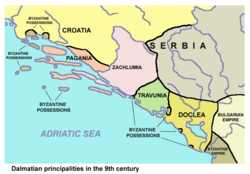
Back Травунія Byelorussian Травунія BE-X-OLD Травуния Bulgarian Travunija BS Travunien German Travunia Spanish Travonie French Travunija Croatian Travunia Hungarian Travunia Italian
Principality of Travunia Травунија Travunija | |||||||||
|---|---|---|---|---|---|---|---|---|---|
| 9th century–11th century | |||||||||
 Travunia in 9th century | |||||||||
| Religion | Christianity | ||||||||
| Government | Monarchy | ||||||||
| Prince | |||||||||
• before 839 | Beloje (first known) | ||||||||
• c. 1054 | Domanek (last independent) | ||||||||
| History | |||||||||
• Established | 9th century | ||||||||
| 11th century | |||||||||
| |||||||||
| Today part of | Croatia Bosnia and Herzegovina Montenegro | ||||||||
Travunia (Serbo-Croatian: Travunija / Травунија; Greek: Τερβουνία, romanized: Tervounía; Ancient Greek: Τερβουνία, romanized: Terbounía; Latin: Tribunia) was a South Slavic medieval principality that was part of Medieval Serbia (850–1371), and later the Medieval Bosnia (1373–1482). The principality became hereditary in a number of noble houses, often kin to the ruling dynasty. The region came under Ottoman rule in 1482. Its seat was in the city of Trebinje.
In the 9th and 10th centuries, the Župa of Travunia was held by the Belojević noble family, who were entitled the rule during the reign of Prince Vlastimir (r. 830–850), of the Vlastimirović dynasty. After the death of Časlav, the last dynastic member, the principality disintegrated, and the provinces were annexed by the Bulgars and Byzantines. In 1034, Stefan Vojislav (the founder of the Vojislavljević dynasty) incited a rebellion and renounced Byzantine rule, becoming the Prince of Serbs, ruling from the seat at Duklja. In the early 12th century, Desa of the Vukanović dynasty wrestled the region, and it continued under the rule of the Nemanjić dynasty (1166–1371), either held by dynastic members or close associates (most often military commanders), of which was the notable Vojinović noble family. After Nikola Altomanović, the holder of a large province during the fall of the Serbian Empire, was defeated in 1373, his estates were divided between Prince Lazar Hrebeljanović of Serbia, Đurađ I Balšić of Zeta, and Ban Tvrtko I Kotromanić of Bosnia. Trebinje continued under the Bosnian crown in the hands of the Pavlović family, and from 1435 under the Kosača family. It was finally annexed in 1481 by the Ottomans and organized into the Sanjak of Herzegovina.